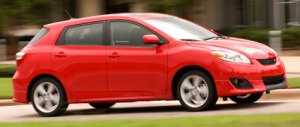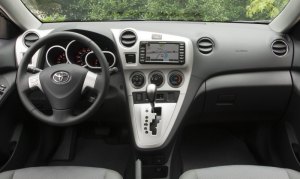|

|
Ugly duck bears little resemblance to
the old Matrix, although dimensionally it is nearly unchanged.
|
The
second generation Toyota Matrix follows exactly the same formula as the
original car. First of all, it is derived from the Corolla platform to
reduce development and production costs. Secondly, unlike Corolla, it
is a SUV-style multi-functional hatchback aiming at young customers.
Thirdly, it is a joint venture with GM - still a surprise today
considering they are arch-rivals. Production takes place at the JV
plant NUMMI in the United States, where its sister car Pontiac Vibe is
also assembled. As before, Toyota is fully responsible for the
engineering and parts sourcing, so Pontiac Vibe is only a
badge-engineered version of the Matrix.
The new Matrix doesn't break the mold of its predecessor. It is almost
identical to the old one in form and exterior dimensions. Nevertheless,
its new styling actually takes a backward step. The oddly shaped
headlamps and bonnet, the BMW-flame-surfaces-style waistline and the
cheap-looking plastic window frames reflect poor taste from its
California designers. Comparatively, the stylists of GM did a much
better job on Pontiac Vibe, making the latter more worthy to purchase.

|
XRS model gets aggressive aero kits,
large Camry engine, sportier rear suspensions and tuning.
|
Open
the doors, you will find one of the worst cabins by Toyota. Hard
plastics everywhere, cheap seats and fabrics, average assembly quality
(very rare for this company) and plain design imply this is a cost
conscious vehicle designed for the American. Just beware of the Korean,
as they can build cars cheaper yet higher quality these days. Well,
perhaps the Japanese firm wants to save the best for itself rather than
sharing with GM. On the plus side, the cabin has plenty of space
because the Matrix is a tall car. A fold flat rear seat enables a large
yet convenient cargo area, although this has become a norm of the class.
Under the bonnet lies a 1.8-liter dual-VVT-i engine like Corolla. We
love its 132 horsepower and reasonable fuel consumption, less so the
vocal manner at high rev. A more refined and torquey alternative is the
2.4-liter VVT-i four-pot, good for 158 horses like in Camry. This XRS
model has another advantage over the 1.8-liter model: a double-wishbone
rear suspension instead of torsion-beam. Now you might remember Toyota
Auris / Blade, the hatchback version of Corolla, has similar mechanical
designs. If you have a global vision of automotive industry, you will
find few things are new.

|
High-mounted gear shifter aside, I
don't see anything in this cabin worth praising.
|
Predictably,
the Matrix is not a driver's car as its aggressive looks suggested. Its
electric power steering is light and short of feel. Its body control is
average. Its chassis dynamic is uninspiring. The XRS with stiffer
suspensions, front tower bar and 215/45R18 tires performs better in
corners, but still no one will describe it as an engaging drive.
There is nothing wrong to follow a proven formula. However, if you
think you can rest on your laurels and devote little effort on the
development, you will end up in something as forgettable as the second
generation Matrix. The next 5 years will be difficult to it.

|
Comparactively, sister car Pontiac
looks far more tasteful, although under the sheet metal is the same
thing.
|
|